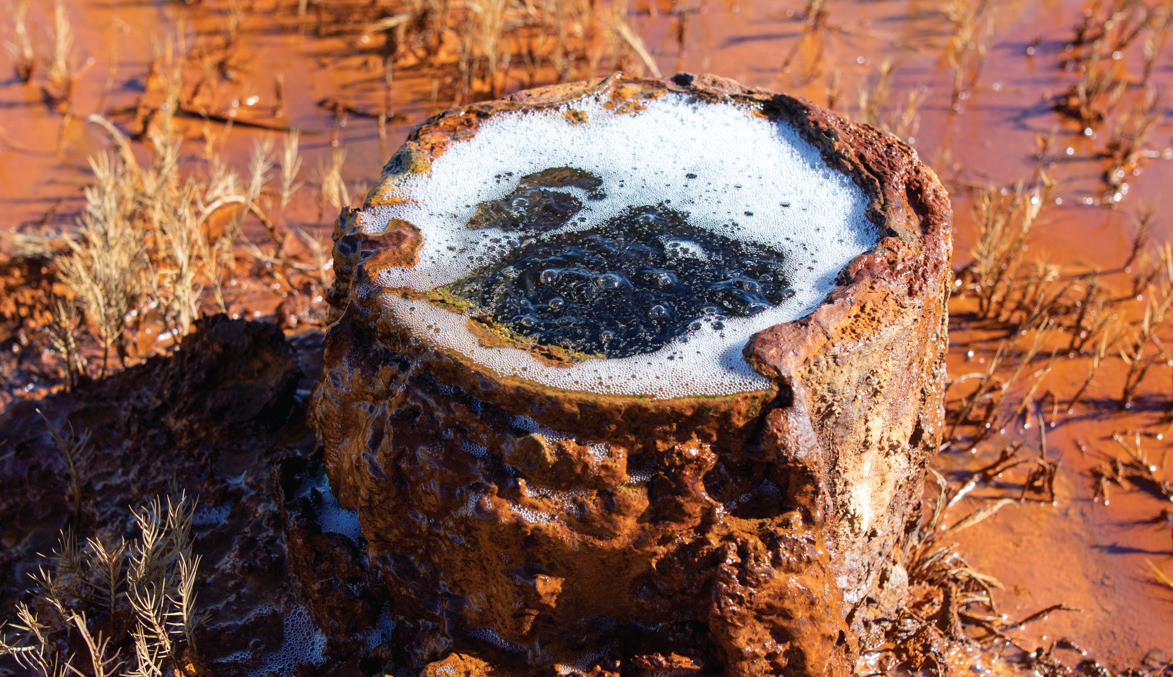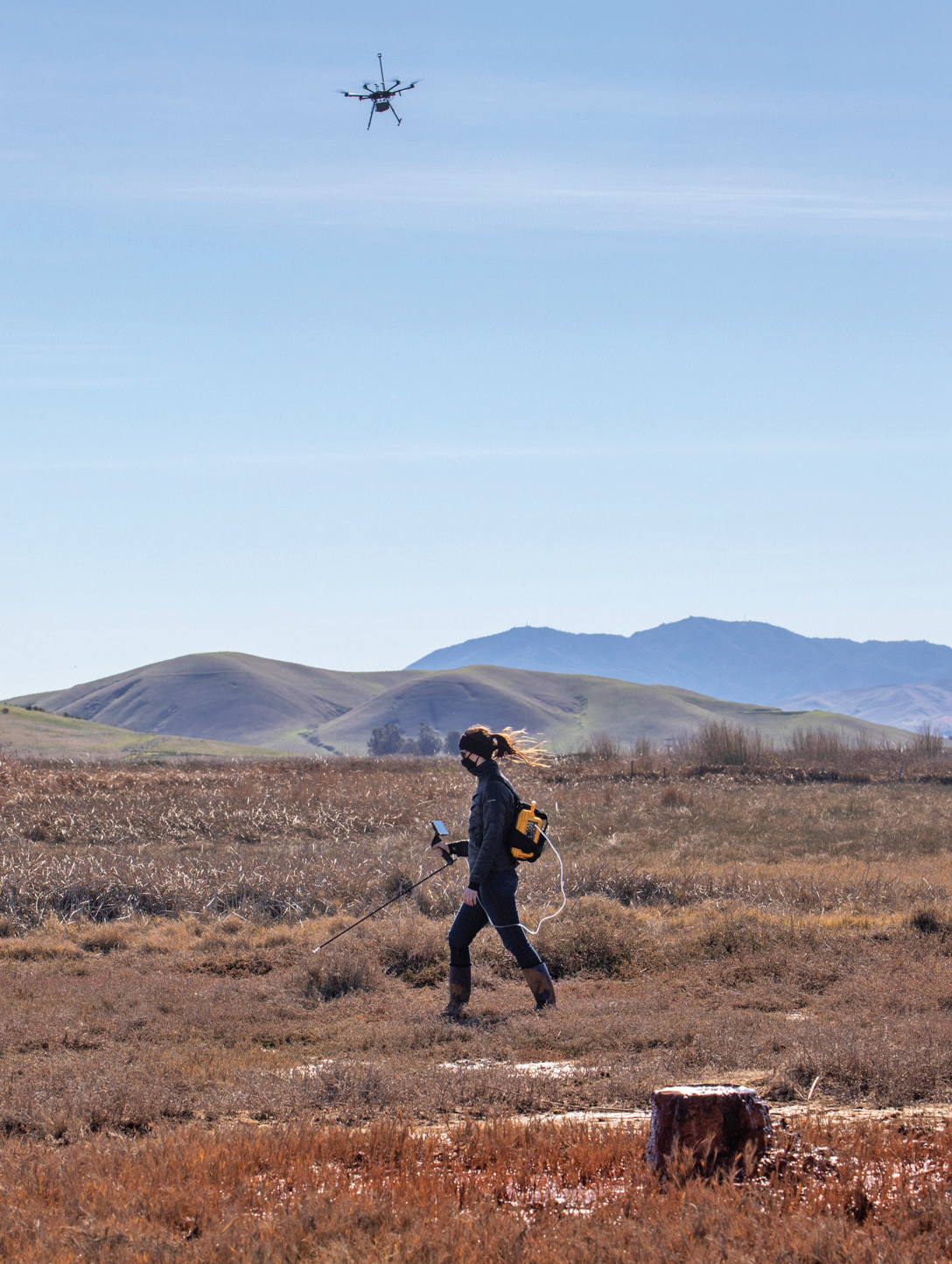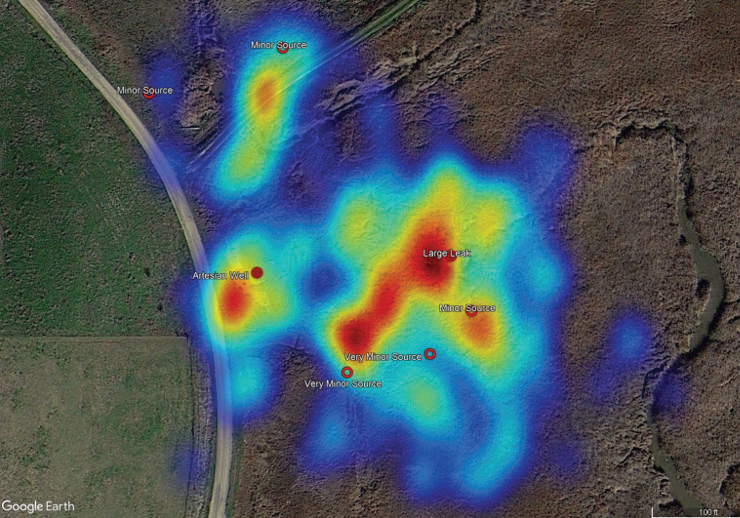In the United States, which is thought to have 3.2 million wells that are either abandoned, with no owner or operator or deserted by identified owners, methane gas leaks are becoming an increasing phenomenon.1

Abandoned artesian well showing bubbling gas emissions. Image Credit: ABB Measurement & Analytics
The University of California Berkeley (Lawrence Berkeley Laboratory) commissioned ABB, funded by the California Energy Commission, to conduct measurements over an abandoned gas well with HoverGuard™ 60 miles north of San Jose.
The objective was to show how effective ABB’s system is for measuring gas leaks in real-world applications. ABB employed its drone-based HoverGuard™ detection system as the primary analysis method.
The company also deployed its MicroGuard™ (hand portable) and MobileGuard™ (vehicle-based) to display how effective each system can be while gathering data about how they function in a real-world scenario.
HoverGuard™ demonstrated the capacity to find and characterize the suspected leak but also discovered another, much larger leak. This second, larger leak was previously unknown, originating far from the road but having a considerably greater emission rate.
Detection of Methane Gas Emissions
Natural gas remains a key part of the energy mix, and many see it as a valuable fuel for the transition of electricity generation between highly polluting coal and more permanent non-fossil energy sources such as wind and solar power.
It also plays a crucial role in balancing out demand when renewable sources are not able to operate effectively. Although there will be a reduction in the demand for gas in the coming years, consumption by 2024 will need to be greater than what the IEA considers ideal if net-zero targets set for 2050 are to be met.2
Natural gas mostly consists of methane, in combination with lower percentages of other hydrocarbons. It is also comprised of water, carbon dioxide, nitrogen, oxygen, and some sulfur compounds.
Carbon dioxide receives the majority of the attention for its atmospheric warming potential, yet methane is the second main greenhouse gas and is of increasing concern. Despite having a shorter lifespan than CO2, the potential of methane’s heating is up to 84 times greater over a 20-year period.
In 2019, atmospheric methane hit record levels, at more than two and a half times the level of pre-industrial times. Primary sources of methane emissions include coal mining, landfill, livestock, manure, and natural gas, with natural gas production and distribution accounting for the majority, at over 30 percent of all emissions.
Government and environmental agencies have recognized the need to curb such methane emissions: this is the main objective of the Global Methane Pledge. Signed at COP26 by over 100 countries, the aim of the pledge is to reduce methane emissions in the atmosphere by 30 percent by 2030.
It is believed that such a reduction has the potential to achieve at least a 0.3 °C reduction in global warming by 2040. More efficient use of natural gas is a way to reduce its environmental impact, and the IEA advises the gas industry to act quickly and effectively to reduce nonessential methane emissions.
As well as meeting environmental concerns, the ability to detect and fix a gas leak quickly also makes for common sense from an economic and safety perspective. Pipelines from which gas leaks represent a loss of billions of dollars of revenue every year, from direct product loss and the work and costs required to replace it.
Data from the US government’s Pipeline and Hazardous Materials Safety Administration (PHMSA) indicates that between 2000-2019, 686 serious incidents occurred on gas pipelines, contributing to 253 fatalities and 1,111 injuries.3
This means that those responsible for operating gas wells and pipelines need to become better at detecting gas leaks from their facilities. As well as limiting monetary losses from the escaping gas into the atmosphere, they will also be contributing to the reduction of methane’s contribution to global warming.
To facilitate this, a rapid, effective and efficient method of detecting leaks is a must. So far, conventional methods employed to detect gas leaks have not been fully fit for this purpose. As well as being slow, they lack the accuracy and sensitivity required and, even more so, they lack the ability to detect leaks efficiently and reliably.
These techniques are dependent on handheld analog detectors that technicians have to carry across the suspected gas leak area. The devices used in these techniques require sufficient time to calibrate on-site and also have a low detection rate, which means users must tread slowly over the investigation site.
The test data needs to be manually added to systems, further increasing the time necessary for an effective evaluation of a potential leak. Recently, technological advances have ushered in improvements in sensing, analytics, and mobile technology. These advances facilitate the development of enhanced techniques that perform considerably better than conventional methods.
These systems are able to detect methane from natural gas leaks at concentrations of 1 part per billion (ppb).
ABB leads the innovation in this field, having produced a range of gas detection applications based on its LGR-ICOS™ technology. The latest, known as off-axis integrated cavity output spectroscopy (OA-ICOS), employs a tunable laser that generates light at a selected wavelength to interact with the methane and ethane gases that need to be detected.
This can achieve a sensitivity more than 1,000 times greater than traditional technologies and detect leaks at distances of around 100 meters. The laser passes into a highly reflective mirrored cavity, which is reflected thousands of times before its egress onto a photodetector.
This results in the laser following an extremely long optical path of several kilometers, generating an increased measurement sensitivity and creating strong absorption of the infrared light by the gas. Adjusting the wavelength of the laser enables the gas concentration to be measured with high precision and accuracy.
The method is able to detect the targeted gas in single parts per billion. This ensures that variations in atmospheric concentrations can be rapidly measured from long distances, a feat that other technologies find hard to emulate.
The Nurse Slough Road Survey
Why the Survey Was Conducted
The number of orphan oil and gas wells present is a significant risk to both the climate and public health. These wells are often disowned by companies that leave the site after falling into bankruptcy or fraudulent activity; subsequently, the wells will potentially leach methane into the atmosphere.
This is an increasing problem; for example, it has been estimated that the number of abandoned wells in Texas and New Mexico could rise by nearly 200 percent in the coming years. It is also anticipated that clean-up costs will run into the hundreds of millions or even billions of dollars nationwide, yet both the real cost and number of abandoned wells remains unknown.

HoverGuard™ surveying over the abandoned gas well. Image Credit: ABB Measurement & Analytics
The US Environmental Protection Agency (EPA) believes that the number of unplugged orphan wells across the United States could be as high as 2.1 million.4
To investigate how effective ABB’s detection technologies in real-world conditions are, the University of California Berkeley (LLBL) asked ABB to conduct measurements over an abandoned gas well 60 miles north of San Jose with HoverGuard™.
On March 23rd, 2021, ABB surveyed an artesian well in Solano County, California, which is situated on private property off Nurse Slough Road. Located between a number of old oil exploration fields, the site includes a marsh that runs the periphery of the public road.
ABB used its HoverGuard™ as well as MicroGuard™ and MobileGuard™ technologies to demonstrate how they could be applied in real-world scenarios to identify and analyze methane leaks from wells.
Survey Methodology
One of the main objectives of the March 2021 survey was to follow up on a survey previously conducted in February 2021 that suggested a much larger and previously unknown source was present further into the marsh.
During the initial site visit, this source was not investigated further due to the terrain being difficult to access. However, the team marked the site for further investigation to confirm the methane source extent and release characteristics.
During the March survey, ABB assessed the site with three commercially available ABB technologies: MobileGuard™, HoverGuard™ and MicroGuard™.
The method used was similar to that of the first survey. The vehicle-based MobileGuard™ performed several drive passes along the adjacent road, while HoverGuard™ evaluated the site from the air; the aerial survey was conducted using encircling lawnmower patterns at two altitudes and a fence-line pattern.
The MicroGuard™ investigation was different due to the follow-up survey’s main objective being to locate a previously suspected larger emission that existed further into the marsh.
This location was particularly difficult to access due to the surrounding terrain, which consisted of tall marsh reeds, deep water, and mud. As a result of this, the MicroGuard™ investigation employed indications from the UAV as a starting point but then followed an improvised path based on walkability.
The ABB Products Deployed
HoverGuard™ conducted a series of four distinctive surveys of approximately 20 minutes, each using the exact same survey patterns as in the February visit. As with the initial survey, HoverGuard™ was able to detect the artesian well, together with a large, previously unknown emission source located further into the marsh.
On the second day of the survey, additional smaller emission sources were identified due to the lower winds. In addition to the UAV-based inspection, ABB conducted a follow-up vehicle-based, MobileGuard™ investigation. The UAV inspection was able to access locations downwind because the wind conditions were coming from the same consistent southerly direction as the first survey.
The site of the large leak was totally inaccessible by conventional vehicles, while the artesian well was only sampled at the perimeter of the emission plume. However, MobileGuard™ was able to detect the nearest source (the artesian well) because some of the emission was dispersed to the roadway by the southerly wind.
With its high sensitivity, MobileGuard™ could discern the emission and roughly guess its location and flow rate. A number of minor sources north of the levee were easily detected.
During the final stage, ABB performed a pinpointing operation applying the data acquired from HoverGuard™. This focused on discovering the source of the hard-to-reach large emissions at an unknown location in the marsh.
As well as quickly locating the artesian well, MicroGuard™ was also able to locate several other sources deeper into the marsh. During the first survey, the largest of these was inaccessible but was reached in the second survey in March 2021.

Surveying the marsh while walking using MicroGuard™ as HoverGuard™ surveys from above. Image Credit: ABB Measurement & Analytics
Key Findings During the March Investigation
ABB surveyed with HoverGuard™, MobileGuard™ and MicroGuard™ and each system demonstrated the ability to rapidly detect gas emissions from the artesian well accurately. MicroGuard™ was able to recognize the large leak as previously indicated, which was found 50 meters deeper into the marsh than the artesian well.
The methane emission rates estimated using HoverGuard™ and MobileGuard™ generally agreed with a chamber flux measurement that uses a sealed tent to measure methane concentrations. They were also clearly within the margin of error, indicating their ability to quantify and rank the severity of the source.

Detection density for all flights conducted on March 23, 2021. The various sources (including the artesian well, large leak or previously unknown source, as well as several others) identified with the MicroGuard™ handheld sensor are clearly highlighted by the data collected by HoverGuard™. This visual representation does not reflect emission severity, but rather leak localization probability. Image Credit: ABB Measurement & Analytics
Conclusions drawn from the exercise:
- HoverGuard™ detects and localizes large, small and hidden leaks that other technologies cannot
- MobileGuard™ finds and quantifies leaks easily
- MicroGuard™ pinpoints leaks quickly, no matter where they are – the solution can be used to quantify leaks accurately (with a controlled tenting strategy)
With older technologies, the difficulty in identifying leaks of this magnitude increases uncertainty on the estimates of methane emissions from a large number of uncapped and undocumented wells across the USA.
Previously used optical sensing methods based on aircraft-based sensors cannot detect any of the site-based emissions, even the large source.
Most, if not all, flight-based methane detection systems measure the absorption or scattering by the methane column density or the gas concentration and effective optical path length. Since the methane was spread across a large area, the column density along the line of sight was low, but the total emission rate was not insignificant.
ABB’s Products for Gas Leak Detection, Mapping and Quantification
MobileGuard™
ABB’s MobileGuard™ system is a system that can be vehicle-mounted to enable accurate natural gas leak detection while surveyors are driving. The system utilizes an LGR-ICOS™ methane and ethane gas analyzer in addition to an ultrasonic anemometer for measuring wind speed and a Global Navigation Satellite System (GNSS) for measuring location.
Employing ABB’s sophisticated mapping and quantification algorithms, the MobileGuard™ system is able to locate, map, and quantify the size of a pipeline leak from a vehicle traveling far from the emission source.
The system takes numerous measurements per second, conducting accurate leak surveys while driving at speeds of up to 88 km/h (55 mph). This means that surveyors are able to cover 10-25 times more land area per minute than with conventional methods.
The analyzer is able to measure both methane and ethane concentrations, meaning it has the capacity to distinguish between pipeline gas or naturally occurring methane and thus virtually eliminate any false positives.
The MobileGuard™ system locally analyzes data and displays geospatial maps of all measured parameters in real-time. Data and analyses can be securely relayed to cloud storage for easy sharing, archiving and further analysis.
HoverGuard™
When methane leaks from a pipeline, it subsequently decreases in concentration as it mixes with the air and moves further away from the leak source. Detecting this methane can be accomplished by passing an airborne analyzer through the diffused methane, allowing its concentration levels to be quickly calculated.
ABB’s HoverGuard™ is a UAV-based solution that can offer rapid, inexpensive, and safe methods for determining potential leakage sources. It also grants access to hard-to-reach areas that remain inaccessible either by foot or by vehicles, such as bridges, high-rise buildings and areas that present a significant risk to human health and safety.
HoverGuard™ is cheaper to run than aircraft-based analyzers and can operate much closer to the ground and leak sources. Due to the fact the drone is able to sample the air at a rate of five times per second as it flies, it offers advantages over alternative techniques. Most crucially, it offers greatly improved accuracy over laser-based systems using a scattered or reflected laser beam.
The speed with which data can be acquired without putting accuracy at risk means that the drone can detect, locate and estimate the size of natural gas leaks while surveying 10-15 times more land area per minute than conventional methods. Additionally, with its fast response rate and extremely sensitive technology, it can detect leaks rapidly at distances greater than 100 meters (328 ft) from its source.
MicroGuard™
MicroGuard™ utilizes the same ultrasensitive detector technology as the MobileGuard™ system but has been optimized to be carried by technicians performing surveys on foot. The technology is comprised of an LGRICOS™ gas analyzer, backpack, ruggedized tablet with GNNS capability, sophisticated analysis software, and a custom-designed sample wand.
The MicroGuard™ system facilitates the simple and accurate pinpoint location of natural gas leaks within minutes. Its software produces detailed digital reports of the survey, which can be shared instantly across secure networks.
Conclusion
Methane leaks from abandoned gas wells are an increasing phenomenon, both in the USA and globally. Detecting this potent greenhouse gas is vital if the world is to meet its ambitions of slowing the rise in global warming.
Evaluating the accuracy of ABB’s laser-based techniques and the practicality of different mounting systems was the primary aim of the project to detect leaks at a site bordering Nurse Slough Road in California.5
ABB demonstrated that its solutions worked effectively in real-world conditions. HoverGuard™ is able to detect and localize large, small, and hidden leaks that other technologies are not able to.
The tests also showed that MobileGuard™ has the capacity to easily locate and quantify leaks. MicroGuard™ was also employed in these scenarios, and tests demonstrated that it can quickly pinpoint leaks, no matter where they are.
The solution can be used to accurately quantify leaks in conjunction with a controlled tenting strategy. All the methods utilized ABB’s laser-based technology (OA-ICOS) that measures methane and ethane gas simultaneously with a sensitivity more than1,000 times greater than traditional methods and has the capacity to detect leaks at distances over 100 meters from the source.
The technology’s accuracy, as well as the dynamic versatility of the deployment techniques, demonstrates that ABB provides a leading method of methane detection that goes beyond the capacities of existing, frequently-used solutions.
Wider adoption of this technology will help locate methane leak sources more accurately and ensure that this problematic greenhouse gas is kept in check.
References
- https://www.nrdc.org/stories/millions-leaky-and-abandoned-oil-and-gas-wells-are-threatening-lives-and-climate
- https://www.iea.org/
- https://www.phmsa.dot.gov/data-and-statistics/pipeline/pipeline-incident-20-year-trends
- https://www.epa.gov/ghgemissions/inventory-us-greenhouse-gas-emissions-and-sinks
- Yingqi Zhang, Veronica Rodriguez Tribaldos, Donald W. Vasco, Barry M. Freifeld, William Foxall, Kang Wang, Roland Burgmann, Brian Leen, Doug S. Baer and Curtis M. Oldenburg. 2021. Monitoring Report for an Integrated Risk Management and Decision-Support System (IRMDSS) for Assuring the Integrity of Underground Natural Gas Storage Infrastructure in California. California Energy Commission.

This information has been sourced, reviewed and adapted from materials provided by ABB Measurement & Analytics.
For more information on this source, please visit ABB Measurement & Analytics.